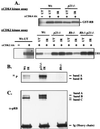Inhibition of cyclin-dependent kinase 2 by p21 is necessary for retinoblastoma protein-mediated G1 arrest after gamma-irradiation
- PMID: 9927683
- PMCID: PMC15340
- DOI: 10.1073/pnas.96.3.1002
Inhibition of cyclin-dependent kinase 2 by p21 is necessary for retinoblastoma protein-mediated G1 arrest after gamma-irradiation
Abstract
In mammalian cells, activation of certain checkpoint pathways as a result of exposure to genotoxic agents results in cell cycle arrest. The integrity of these arrest pathways is critical to the ability of the cell to repair mutations that otherwise might compromise viability or contribute to deregulation of cellular growth and proliferation. Here we examine the mechanism through which DNA damaging agents result in a G1 arrest that depends on the tumor suppressor p53 and its transcriptional target p21. By using primary cell lines lacking specific cell cycle regulators, we demonstrate that this pathway functions through the growth suppressive properties of the retinoblastoma protein (pRB) tumor suppressor. Specifically, gamma-irradiation inhibits the phosphorylation of pRB at cyclin-dependent kinase 2-specific, but not cyclin-dependent kinase 4-specific, sites in a p21-dependent manner. Most importantly, we show that pRB is a critical component of this DNA damage checkpoint. These data indicate that the p53 --> p21 checkpoint pathway uses the normal cell cycle regulatory machinery to induce the accumulation of the growth suppressive form of pRB and suggest that loss of pRB during the course of tumorigenesis disrupts the function of an important DNA damage checkpoint.
Figures





References
-
- Weinberg R A. Cancer Surv. 1992;12:43–57. - PubMed
-
- Nevins J, Leone G, Degregori J, Jakoi L. J Cell Physiol. 1997;173:233–236. - PubMed
-
- Weintraub S J, Prater C A, Dean D C. Nature (London) 1992;358:259–261. - PubMed
-
- Weintraub S J, Chow K N, Luo R X, Zhang S H, He S, Dean D C. Nature (London) 1995;375:812–815. - PubMed
Publication types
MeSH terms
Substances
LinkOut - more resources
Full Text Sources
Research Materials
Miscellaneous

